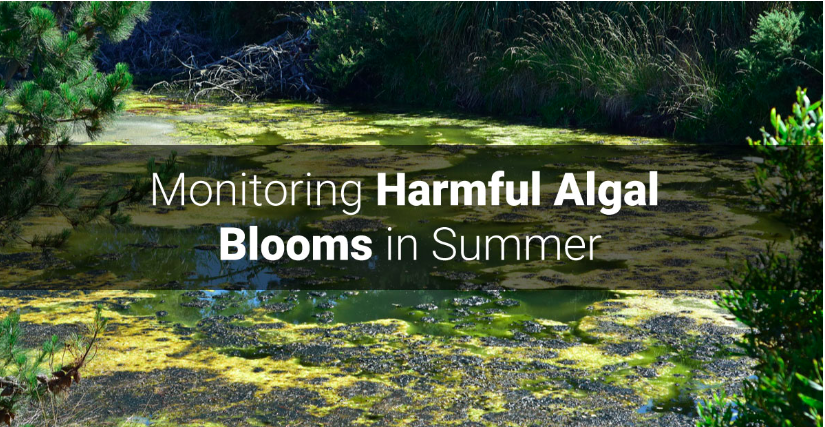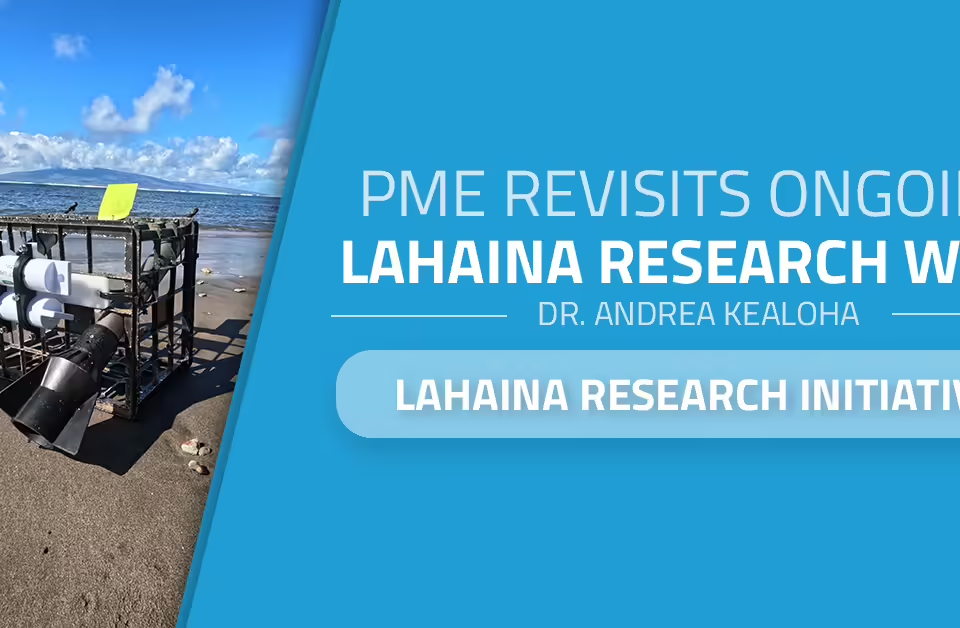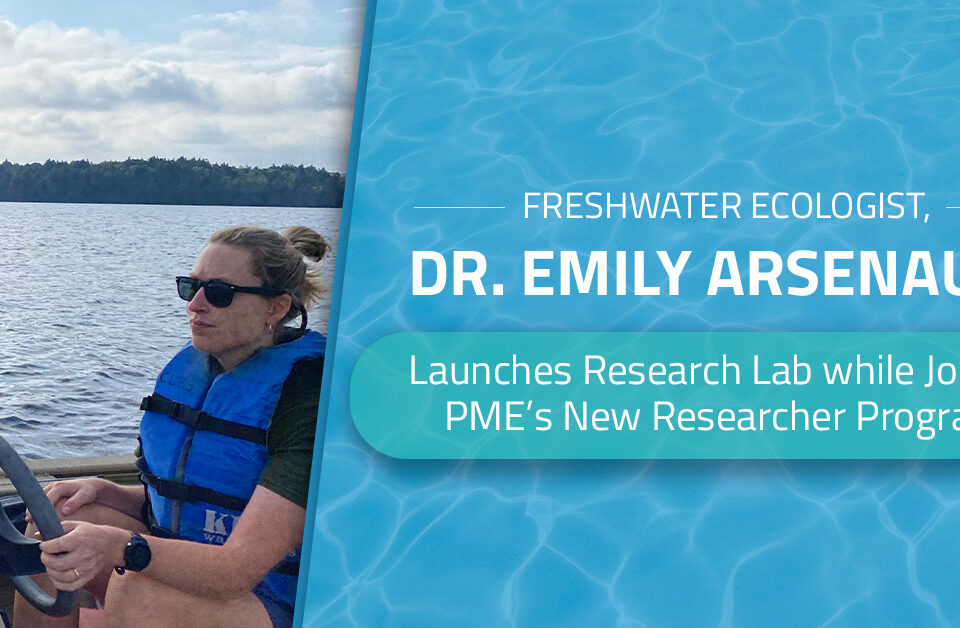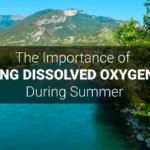
The Importance of Measuring Dissolved Oxygen Levels During Summer
August 15, 2019
Women in Environmental Sciences
September 6, 2019Monitoring Harmful Algal Blooms
Late summer is a great time to be on the water. Hot sun, clear skies and warm water draw recreationists of all stripes—boaters, kayakers, swimmers, fishing enthusiasts—to the water, looking for one last hurrah before the onset of fall. In a few, unfortunate cases, however, late summer weather can contribute to a condition that is not so delightful and may in fact be hazardous to human and animal health: the harmful algal bloom (HAB).
What is a Harmful Algal Bloom (HAB)?
Algae are simple plants which occur naturally and are vital to aquatic ecosystems, providing needed food, oxygen, and shade in both fresh and saltwater. Under certain circumstances, however, colonies of algae can grow out of control, creating and releasing toxins which can be harmful to fish, birds, marine mammals, livestock, and pets. Human illnesses caused by these harmful algal blooms (HABs) are rare but do occur and can be serious, even fatal.
Why Do HABs Happen?
HABs can be naturally occurring, following normal climatic events: periods of warmer water temperatures, sluggish or non-moving water, favorable wind and water currents, hurricanes, floods, and droughts. There is evidence that human activities also play a role in the increasing frequency and severity of HABs. Water flow modification (excessive drawdowns from dams), pollution, introduction of non-native species, and warmer water temperatures brought on by climate change can all contribute to harmful blooming.
Among human causes, however, the largest contributor to harmful blooms is agricultural runoff. Fertilizers used for agriculture (or even routine lawn care) can leach into nearby watersheds, adding nitrogen and phosphorous to waters already teeming with those substances. Late summer is a time of fertility in the water and this influx of nitrogen and phosphorous can make it a time of excessive fertility, causing unnatural and ultimately harmful growth in algae and other aquatic plants.
Effects On Fish, Wildlife, and Humans
HABs produce toxins which can cause illness in fish, birds, marine mammals, livestock, pets, and humans. People and animals can be exposed to these toxins by swimming in HAB-contaminated water, breathing in aerosols from contaminated water (even tiny droplets, sprayed during boating or other activities), drinking HAB-contaminated water, or eating contaminated fish or shellfish. Irritations to the skin, eyes, ears, nose, and throat are common symptoms of HAB exposure in animals and humans. The Centers for Disease Control monitors HAB-related illnesses and offers advice on symptoms and treatment.
Algal blooms produce a large-scale photosynthesis, which releases massive amounts of dissolved oxygen (DO), sometimes supersaturating the water column. Conversely, during the respiration phase brought on by a HAB, large amounts of DO are removed from the water, creating an oxygen-poor environment which is harmful to fish populations.
Dealing With Harmful Algal Blooms
Whether naturally occurring or human-caused, algal blooms can be harmful to animals and humans, as well as the ecosystem at large. Because HABs are not preventable, responsible agencies focus on identifying HABs and potential HABs and steering the public away from them via warnings and closures. An oxygen logger, such as PME’s miniDOT® Logger can help researchers identify HAB threats, present and future, by measuring amounts of dissolved oxygen in the water column.
The graphs below show daily DO readings which demonstrate a pattern indicative of a HAB.
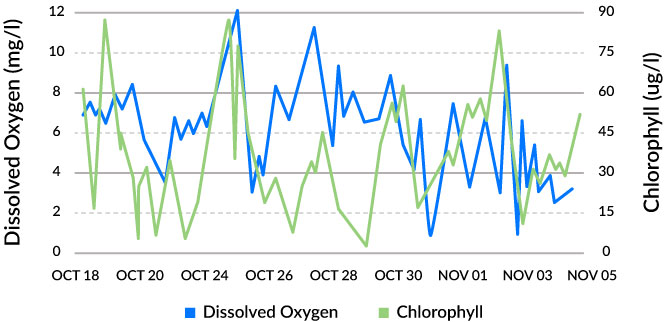
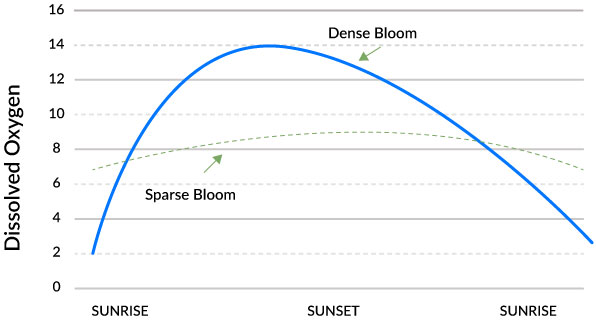
What You Can Do
Stay safe by heeding all warnings issued by relevant agencies. Check websites for your local Parks Department or Department of Fish and Wildlife, as these sites often contain notification of closures and hazardous conditions in local waters. Signage is often present at HAB-affected waters. Obey the signs and keep your pets away from the water as well.
Obey Nature’s warning signs. HABs generally make the water look unappealing. Scum, excessive foam, and discolored water are fairly obvious signs of poor water quality and potentially hazardous conditions. In coastal areas, red tides (which are a form of HAB) are, as their name implies, visibly red, displaying the color that almost always signifies a warning in the natural world. Other HABs may cause the water to be unnaturally blue or green. Avoid unnaturally colored water.
If you begin to experience any symptoms—itchy nasal passages, sore throat, dizziness, stomach upset—which you believe may be attributable to water conditions, leave the area and seek medical attention, and do not return until time and cooling weather have created a change in conditions. This might take weeks or even months.
Alert relevant agencies to both the visible signs of HABs and any symptoms you feel and believe may be attributable to water conditions.
Finally, if you live near a body of water (and we all live upstream of something), be aware that any product you use on your lawn or on the outside of your house will end up in nearby water and may possibly contribute to a HAB. Use only environmentally friendly products, specifically avoiding anything that will add either nitrogen or phosphorous to your local watershed.
Enjoy these last, delightful days of summer but steer clear of harmful algal blooms!



